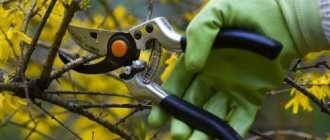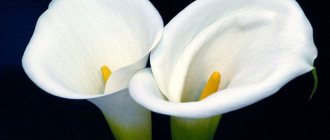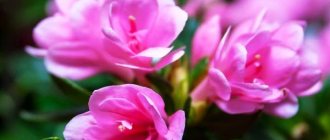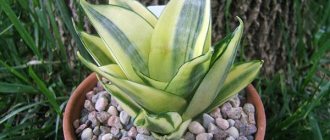Formation of fuchsia
Fuchsia amazes its owners with its bright flowers of unusual shape. The buds combine several shades at once: pink, red, purple. In agricultural technology there is no clear indication of what the crown of the plant should be. The florist can choose any shape. Pruning is more necessary to eliminate weak shoots that will bloom worse. Thin, long branches or shoots with only two or three leaves are cut from fuchsia. Branches that have become woody are also cut off. It is forbidden to touch the plant trunk itself when cutting.
Choosing a season for pruning fuchsia
Initially, the gardener must figure out when to prune fuchsia and for what purpose. Pruning is done in the spring months, until the time when the plant begins to form buds. With proper manipulation, fuchsia will bloom more abundantly and longer. The plant can also be pruned in the fall. The best period will be the last ten days of October or the beginning of November. This method is suitable for indoor plants. In autumn, gentle pruning is recommended, which concerns the parts of the plant where the flower stalks were.
If the plant is still blooming at this time, it is recommended to postpone the procedure to a later period. You can do pruning in winter. But fuchsia must be pruned before wintering, when the plant enters the dormant phase. To prevent it from weakening, there is no need to trim the shoots to a length of less than 15 centimeters. When the crown is formed, only weak shoots are eliminated. They are thinned out and shortened to 1/3 of the original height.
Tools and their disinfection
The gardener should use a knife or garden shears when processing the plant. Before the procedure, the instrument is disinfected to prevent the development of viruses. The scissors are treated with a product containing alcohol (spray, wipes). Kerosene, potassium permanganate or bleach are also used. Place the instruments in an antiseptic solution for several minutes and wipe them with a clean, dry cloth.
Preparing a houseplant for winter
From time to time it is important for every plant to rest. If the fuchsia is in a heated room, it is fed and watered as in summer, then the plant will not have the strength to bloom. In addition, the bush grows quickly and occupies a large area. Before wintering, you should examine how much the branches have grown.
In the first year of fuchsia growth, you should not overwinter with shoots that are too long. Therefore, they are cut short, leaving a length of about 15 centimeters. After the bush is formed, all weakened and diseased branches are cut off. You should not thicken the bush too much, otherwise it will not grow well. The plant should only have strong shoots left, the rest should be cut off, leaving 1/3 of the shoots.
You need to pay attention to semi-ampeloid forms. Their weak shoots break under the weight. Only strong branches are left on the bushes. To switch to winter mode, plants need to drop the temperature to +10 degrees. Therefore, fuchsias are put away in the basement or placed on a glazed balcony. In such a room, the temperature should not be below zero so that the indoor plant does not die.
If there is no cooler place, then you can simply choose a cold corner in the house. When the fuchsia continues to grow, fresh shoots are cut with scissors or pinched.
Before leaving the winter hut, all diseased parts of the plant are cut off and overgrown branches are removed. To make the crown more lush, it is recommended to pinch the tops of the shoots after growth begins. Flowering occurs no earlier than two months after the procedure. In order for the plant to actively produce buds in the summer, it is necessary to pinch it no later than April.
Planting and transplanting
Planting fuchsia
Planting and replanting fuchsia
Small ceramic pots are chosen for planting; in them, the substrate retains a stable temperature and optimal humidity longer. When planting cuttings, ampel forms are evenly spaced in groups of 3–5 pieces, which will give a lush, beautiful bush with hanging shoots.
Bush forms are planted in medium-sized pots, one plant at a time, with the expectation that the roots will entangle the entire lump of earth in a season. In containers that are too large, the roots will begin to rot, and in small containers, they will curl up.
Expanded clay drainage must be placed under the layer of soil mixture. The soil is moistened, the plant is planted, spreading the roots and sprinkled with a loose mixture, and watering is carried out. After planting, it is best to mulch the soil surface with peat, which will retain moisture and acidify the environment.
Fuchsia transplant
Transplantation is carried out in February-March, taking the bushes out of the basement after winter storage
The soil is shed with a weak solution of potassium permanganate, wait about an hour and, holding it carefully, remove the plant along with the lump of earth. If the fuchsia has developed normally and looks healthy, do not shake off the soil, but immediately plant it by transferring it into the prepared mixture, using a pot with a diameter 3–4 cm larger than the previous one
Weakened bushes are inspected before planting, for which the soil is carefully shaken off, damaged roots and weak shoots are removed, if necessary, treated with foundationazole, and then planted
Pruning when wintering fuchsia on the ground
Fuchsia is not recommended to be grown in the garden. It does not tolerate frost well, but in rare cases this type of cultivation is used. Growing is possible in the southern regions of the country, where winters are milder than in Siberia. It is best to plant the plant in a flower garden, placing it in a container so that you can dig up the fuchsia when autumn comes.
When the bush overwinters in a flowerbed, the fuchsia is pruned as much as possible so that only the strongest branches remain. Don't leave all the plants in the ground. It is recommended to dig up some of them. A month before the onset of frost, the bush is prepared for new conditions. Nitrogen is removed from fertilizers and only phosphorus is left. The gardener should reduce the number of waterings and the interval between them.
Plants are kept outdoors until frost occurs. This way they will gradually enter the resting phase. Before the procedure, it is necessary to treat with compounds that protect against fungus. After the product has completely dried, you can trim the bushes. Only woody branches remain unpruned. Green branches simply will not survive the cold winter.
The bush is inspected for the presence of weak, diseased or damaged branches. All the leaves are torn off the branches. All weak and diseased shoots should be cut off. They also eliminate all crooked processes. The remaining branches are cut by a third. Only a few skeletal branches and a trunk are left on the bush. After this, they are inspected for pests. Insects happily eat weakened fuchsia at the beginning of spring.
The plants are dug up and moved to a box. The roots are shaken off the soil and wrapped in damp moss. Despite this, fuchsias often die during wintering. Experienced gardeners prepare cuttings in advance in the fall so that they have something to plant in the spring. Planting material can be created from fragments of branches cut when thinning the bush. They are cut into pieces from 5 to 8 centimeters. Such cuttings should be dug into the ground and kept warm for some time. After rooting, they are removed to the balcony until spring.
Pruning after flowering
After the bush has flowered, it is recommended to partially cut off the branches. This will allow the bush to gain strength. The procedure is carried out twice a year: in September and April. First, all wilted and dry stems are removed from the plant. The next step is for the gardener to cut off all the young shoots. Then the fuchsia is formed to the desired shape. The plant can wrap around supports. Therefore, the stems can be braided or intertwined with each other. In the fall, the gardener should inspect the fuchsia for the absence of pests and diseases. If detected, the diseased branch should be cut off, including the healthy part.
How to achieve lush flowering?
Lush flowering directly depends on pruning. The later this is done, the later the plant will bloom. The procedure is carried out 2 times a year. The first time before winter, and the second time in early spring. Spring pruning occurs in late February or early March. Its main task is to form a beautiful crown with many young shoots, at the ends of which buds appear.
Trimming Features:
- To begin with, all fragile small branches are removed, since there will be no flowering on them or it will be weak.
- Then you can start removing dry and very thin branches.
- To prevent excessive bush density, you need to cut off shoots directed towards the center.
- When pruning shoots, it is necessary to take into account that the crown must be of the correct shape. The cut is made at a distance of 1-2 centimeters from the node.
How to properly form a plant
The plant is distinguished by interestingly shaped flowers that combine several shades. On each branch several thinner stems are formed, on each of which 3-10 inflorescences subsequently develop. The flowers have an outer row of strongly expanding pointed petals, several rows of rounded small petals and long stamens at the core. Each of these parts may be different from the others in color, blue, yellow, white, pink, red or purple.
Note! There is no single requirement on how to form a fuchsia bush correctly. The crown can have any shape depending on your own wishes.
Pruning is necessary to remove the weakest shoots that will bloom poorly. For example, you can immediately remove stems that are too long and thin or those that have only a couple of small leaves, while the rest are distinguished by an abundance of greenery. It is also necessary to trim stems that have become woody over time. Only the trunk of the bush cannot be trimmed.
Types of pruning indoor plants
Pruning is considered an optional part of caring for indoor plants. Not all crops need pruning, but almost no plant can do without strictly hygienic pruning. It is thanks to pruning that the plant maintains a healthy and neat appearance, restores or improves its decorative effect, and maintains a balance between the root system, which is so limited in volume, and the above-ground parts. By improving, stimulating, regulating and restraining plants, pruning indoor crops allows them to reveal their full beauty.
Depending on the task facing this procedure, there are several types of pruning of indoor plants:
- Cleaning or sanitary pruning.
- Pinching and shortening shoots, pinching buds.
- Crown formation.
- Rejuvenating trimmings.
Some indoor plants need only one type of pruning, others need all four. It is not necessary to carry them out at the same time, but doing everything necessary is much easier this way.
Fuchsia has faded: what to do next
What to do with fuchsia after flowering? It is necessary to partially cut the stems, this will have a beneficial effect on subsequent flowering. It is better to prune twice: in early autumn and in mid-spring. First of all, wilted or shriveled stems are removed. After this, young shoots and branches at the ends should be trimmed. Next, the fuchsia is trimmed based on decorative preferences, that is, the desired crown shape is set.
Note! Fuchsia can easily curl around a support. It is often braided so that the stems grow in the right direction. Young stems can be intertwined with each other so that they form one low trunk of an interesting shape.
When pruning fuchsia in autumn, it is important to inspect the branches for the presence of harmful insects or diseases affecting the bark. If something like this is actually found, the diseased branch and its small healthy part will have to be removed.
How to form fuchsia on a trunk: pruning scheme, recommendations
What to do next when the fuchsia has faded? After the fuchsia has faded, the faded cuttings and twigs that have formed above the young buds are removed.
The standard is formed from a healthy cutting with a strong, straight stem. When planting, it is necessary to install a stick to support the main trunk. Next, you need to figure out how to shape the planted fuchsia. To start forming fuchsia on a trunk, you first need to let it grow to the desired height, cutting off all the side shoots. When the stem reaches the desired height, the top is cut off, and immediately after this young side shoots begin to form. By pinching them, you can get a lush flowering bush.
Forming a fuchsia crown is easy; this way you can give it a certain shape. For example, you can give it the shape of a heart, a ball or a small tree, based on the calculation that from each cut piece two more will grow. They will be directed towards the angle at which the trim was made.
Fuchsia pruning scheme
Pinching and forming a fuchsia cutting
You should not pinch the plant too often, at least you should be careful with this before flowering begins. Pinching involves cutting off young shoots and leaves. The ends of very thin branches that have recently formed are cut off, so the tree’s energy is not used to grow greenery that is useless this season, but to ensure that the flowers are large and bloom well. Thanks to pinching, crown growth slows down; it should be done about once every two weeks throughout the summer. Already in the fall, you can do a full crown pruning, without reducing the number of flowers on the bush. Fuchsia, pruned and pinched correctly, will bloom much more abundantly, more luxuriantly and a little longer.
Pest and disease control
Due to excess moisture in the soil, the strong white roots of fuchsia begin to rot. In this case, you need to dig up the plant, thoroughly rinse the roots with warm water, remove damaged areas and re-root the flower.
Gray mold affects different parts of the plant, resulting in soft, watery areas. Diseased leaves and shoots need to be cut off, the planting should be treated with fungicides and watering should be reduced.
Indoor fuchsias encounter another problem - the plant stops developing, and the roots become too tangled with each other. This is a sure sign that the fuchsia is running out of space and needs to be replanted.
The most dangerous enemy of fuchsia is the whitefly, and it is very difficult to notice. She lays eggs on the undersides of leaves, which then eat the leaves and stems. You need to wash the flowers with soapy water and treat them with insecticides.
Sometimes a spider mite appears, which covers the flowers with a whitish web. And also aphids, caterpillars and leaf nematodes, which eat leaves between the veins. The methods of fighting are the same here.
Canna flower (60 photos): types, proper care and planting
Wintering fuchsia in open ground. Winter pruning rules
In most cases, gardeners are advised to dig up fuchsia for the winter and leave it in pots indoors or at home; fortunately, this is not so difficult to do. This will protect the tree from frost by keeping it warm. If the bushes have already reached quite large sizes or there are a lot of them on the site, it will not be possible to store them indoors. In this case, you can simply cover the plants with spruce branches or spunbond. They should survive the winter well. Some varieties need to be cut almost to ground level, covered generously on top, sometimes even sprinkled with 10-15 cm of soil. At the end of spring, the plants are dug up, after which they begin to grow again.
Note ! Annual varieties of fuchsia do not need to be left for the winter; instead, cuttings will have to be re-rooted every year.
Types of home fuchsia with photos and names
Fuchsia graceful
Fuchsia graceful is a small shrub up to 1 meter in size. The flowers are drooping, bell-shaped, with a pronounced reddish tint. The calyx of the flower is formed by four concave petals, of a reddish hue. The corolla is much shorter in length than the calyx. The color is usually a bright purple hue.
Fuchsia Magellanica
The shrub reaches a height of five meters. However, as a rule, there are specimens up to 2-3 meters. The Magellan species is native to South America, particularly Argentina and Chile. The leaves are elongated, reaching a length of up to 5 cm. The veins are purple, the tips of the leaves are jagged. The flowers grow solitary, often collected in groups of 4-5, drooping. Oblong in shape, reminiscent of a funnel, with a slight reddish tint. Petals at the base with a slight blue tint.
Fuchsia brilliant
Evergreen shrub, up to 1-2 meters high. Habitat: Mexico. The leaves are large, oblong in shape. They reach a length of up to 20 cm, a width of 10-15 cm. The corolla is an elongated narrow tube up to 10 cm long. Inflorescences are racemose. Blooms profusely from June to August.
Fuchsia boliviana
Branched shrub, evergreen. Homeland - South America. Often found in Ecuador, Guatemala, Bolivia. Maximum height 1-1.2 meters. The ovoid leaves reach 15 cm in length. The flowers are tube-shaped, large, bright red.
Useful tips for gardeners on pruning and shaping fuchsia bushes
Many people are interested in how to prune fuchsia at home and whether it should be done at all. Pruning fuchsia at home should be done less often than when growing in open ground. A significant difference will be the size of the bush and the thickness of the stems. If in natural garden conditions you can get a bush-shaped tree 1.5 m high, then at home a small bush no more than 20-30 cm will grow.
Important! We need to figure out how to prune such a small fuchsia without cutting off excess stems. The pruning scheme is the same as for large bushes; young shoots are cut off by 1-2 cm so that several new ones grow in their place.
Growing fuchsia at home is a little easier due to the absence of the need to replant for the winter, and the temperature regime will not change so much throughout the year. And in summer, the scorching sun will not fall on the flower, whose rays often burn through the delicate leaves of fuchsia growing in its natural environment.
Plants that have miniature shapes and small leaf sizes, as well as the flowers themselves, require much less effort and can bloom much earlier than other varieties. They do not require as much care and will bloom even in not the hottest climates.
Fuchsia is a versatile plant that can grow as shrubs, hanging plants or low-growing trees. The plant produces flexible shoots that provide a cascading crown. Growing the crop can be done indoors or in the garden.
Description of the flower and popular varieties
Fuchsia is an evergreen perennial and incredibly beautiful flower, which has many varieties and varieties. For example, a plant comes in different shapes:
hanging tree (has smooth shoots that fall down);
bush (has smooth stems that grow upward);
low-growing tree (very similar to small bonsai trees).
During the growth process, fuchsia forms flexible shoots, which, as they grow, form a crown. The leaves of the plant are small, and the flowers are bright and can have a wide variety of shades, from white to blue, green and purple. Fuchsia blooms for a long time: from spring until the first cold weather.
Hybrid varieties are more suitable for growing at home. Depending on the growth, the following types of fuchsia are distinguished:
- Bush. Most often they are grown in the countryside in outdoor containers. Among the bush varieties there are such varieties as “Armbro Campbell”, “Alisson Bell”, “Anabel”, “Henriette Ernst”, “Talia”.
- Ampelous. This variety is convenient to grow in hanging pots, since as the flower grows, it forms long shoots that fall down. Among the hanging varieties, such varieties as “Hollies Beauty”, “Prince of Peace”, “Blue Angle” (“Blue Angel”), and “Imperial Crown” are very popular.
Features of the flower
There are a huge number of fuchsia varieties. The plant has a variety of flowers, which can be simple or double. In some types of fuchsia, flowers are collected in inflorescences. The plant is characterized by the presence of small foliage, the length of which can reach five centimeters. The leaves of the crop are colored bright green. The leaves are oval in shape and slightly pointed at the ends.
The color of the flowers of a plant can be varied, which allows the gardener to choose the most suitable option in accordance with the landscape design. In their shape, flowers can resemble bells or dancing ballerinas. The place where petals are formed is the tubular corolla. When the flowers are in full bloom, they resemble fluffy skirts. The decorative effect of the flower is ensured by the presence of long stamens. Fuchsia is a rather attractive flower that any gardener dreams of placing in his garden.
Most common varieties
Fuchsia growing and care at home
Many modern varieties are characterized by bright color combinations.
Fuchsia Blue Vale
This is a universal variety; it can be grown either as a bush or as an ampel. The snow-white sepals of double, large flowers have a green tint along the edge. The flower's skirt is fluffy and lavender in color.
Flowering is long lasting and very abundant.
Fuchsia Bella Rosella
The plant has some of the largest flowers (10-12 cm). They are terry, bright, lilac-pink with snow-white stamens and pale pink sepals. Flowering is abundant and long lasting.
Fuchsia variety Bella Rosella has an ampelous and bush form. It is unpretentious and can grow in shade.
Variety Bella Rosella
Fuchsia Blue Angel
Blue Angel variety is an exquisite, memorable fuchsia. The flower size is up to 12 cm in diameter. The corolla (skirt) of the flower is double dark lilac in color, the sepals are white. When fully bloomed, white stamens with pink anthers become a spectacular accent. The bush is semi-ampelous (drooping).
Fuchsia Hollis Beauty
The flowers are large (7-8 cm), double, white sepals, lilac-blue skirt. The bush grows very neatly, has a compact shape, and branches well. The variety tolerates heat and bright sun better than other fuchsias.
The flower is elegant, contrasting, white-green sepals set off the purple-pink skirt. Especially good in full dissolution. Pink elongated stamens set off milky white anthers.
Important! The growing form is ampelous; the lashes of an adult plant grow up to 60 cm in length.
Fuchsia Blue Ice
The plant was obtained as a result of the starting mutation of the Dark Eyes variety in 1954 in the United States of America. Large, double flowers are distinguished by a characteristic arrangement of petals. They resemble a multi-layered petticoat. The color of the petals is deep lavender, the sepals are light crimson. It is interesting that in plants of this variety, flower petals can vary in color intensity. The variety is undemanding; it is grown in bush and hanging forms. Grows quickly, restrictive pruning is recommended to form a dense crown. Feels good in partial shade.
Fuchsia Bicentennial
Fuchsia ampelous Bicentennial is painted in salmon-orange tones. The characteristic magenta strokes along the edge of the multi-layered skirt create an extraordinary color contrast. The flowers are elongated, rather large, in the form of buds. Light sepals become bright orange over time.
The variety was bred by Californian gardener Ted Pasquesen in 1976 and dedicated to the 200th anniversary of US independence. Paskesen carried out lengthy breeding work to obtain a variety that was resistant to heat and strong winds.
The plant forms a dense, branching crown and blooms profusely.
Variety Blue Mirage
Growing conditions
Fuchsia ampelous is a soil-unpretentious flower. That is why it can be planted in almost any soil mixture. In most cases, plants are grown in pots that are pre-filled with universal soil. It is best to give preference to a soil mixture with a loose structure. Sand, peat or ash must be added to it. The substrate can be prepared independently from:
There is another option for preparing a substrate from humus, turf soil, compost, and peat.
In order to provide optimal conditions for the flower, it is necessary that there be high air humidity indoors or outdoors. That is why it is recommended to place a container pre-filled with water near the pot. Flower growers are also recommended to regularly spray the crop.
Fuchsia should be placed in moderate lighting conditions. At the same time, flower growers make sure that the flower is not constantly in shading conditions. The location of the culture should be a balcony or western, eastern windows. This will provide adequate lighting to the plant in the morning and evening.
To ensure that the crop produces the optimal number of inflorescences, a certain temperature regime is observed. During the daytime, the air temperature must be between 20 and 22 degrees. At night, it is necessary that it decreases by 4 degrees. At excessively high temperatures, there may be no flowering, which will negatively affect the decorative qualities of the plant. Also, if this condition is not met, the crop may shed its leaves.
Providing optimal conditions is the key to the success of full growth and flowering of fuchsia.
Plant care
Fuchsia needs to be provided not only with certain growing conditions, but also with optimal care. The crop needs regular fertilization. This procedure should be carried out after the flower is transplanted and it enters the active growth phase. In most cases, mineral complex fertilizers are used for fertilizing. In most cases, the corresponding formulations are purchased from specialized stores in the form of Effecton or Kemira.
Fertilizers should be applied to the soil for the first time in March. After this, their number is gradually increased. In autumn, the volume of fertilizers should be reduced. This procedure is not recommended during the winter period.
Pruning of fuchsia should be carried out throughout the growing season. This will make it possible to create favorable conditions for the full growth and flowering of the crop. After the plant cuttings have taken root, it is recommended to pinch them. Next, the crop is regularly pruned until it blooms. In the summer, pay attention to the longest shoots, which bloom by autumn.
In order to create a beautiful crown, it is recommended to trim the side shoots that are located above the 3rd pair of leaves. This procedure will ensure the formation of a standard form. In order for the plant to have a central shoot, a support is installed. In this case, the side branches must be removed.
What kind of soil does fuchsia like?
The quality of development of any plant depends on the soil. It provides nutrition, moisture, and promotes proper aeration of the roots.
Fuchsia prefers light, fertile soil. Good drainage is required. Neutral acidity is desirable, but slightly acidic is also suitable.
As a base, you can use purchased soil, for example, universal. For this crop it will have to be diluted with sand. But it is best to prepare the soil mixture yourself.
What soil is needed for fuchsia
There are several options for mixing it yourself.
For the first, you can mix an equal amount of peat, rotted leaves, compost and add double the volume of sand.
A good composition would be loamy soil, peat and sand. Recommended proportions are 7:3:2.
If you have loamy or sandy loam turf, you can create a mixture based on them. How the supplement goes:
- granulated peat (or leaf humus);
- wood ash.
If the turf is from pastures, that is, very nutritious, you can mix it with a small amount of peat and sand (6:2:1). With a slight correction, it can also be used for planting cuttings (4:2:1).
Important! It is not recommended to use fine sand from the quarry. Only river fish will do - large, washed.
In recent years, coconut soil has become fashionable. It is made from the hairy skin of nuts. The material is extremely moisture-intensive, rich in microelements, and decomposes for a very long time.
For fuchsia, adding it to the soil is simply a salvation. It is almost impossible to pour the coconut mixture, which means the plant’s roots are safe.
Sometimes sphagnum moss is used to increase the breathability of the soil.
Also add a small amount to the mixture:
- complex fertilizers (for flowering plants);
- vermiculite;
- pine needles;
- hydrogel.
Note! When planting, be sure to add a high layer of drainage. You can use broken bricks, pebbles, etc.
The finished mixture must be sterilized before planting. Disinfection can be achieved by calcination and deep freezing. True, then you will have to populate the soil with beneficial bacteria. Biological products (for example, phytodoctor) will help with this.
Features of reproduction
Fuchsia ampelous can reproduce in several ways. Most often, cuttings or seeds are used for this purpose. The first method is simpler, which is explained by the fastest rooting of the flower. To carry out the procedure, it is recommended to give preference to young cuttings, the length of which is 7-15 centimeters.
It is necessary to remove the lower foliage from the cuttings and place them in water. Storage of cuttings should be carried out at room temperature. After a week, roots appear on the cuttings. During this period, the material is planted in the soil mixture.
There is another way to propagate ampelous fuchsia, which involves planting cuttings in the substrate immediately after cutting. To avoid loss of turgor by the foliage of the cutting, the container with it must be placed in a greenhouse. After the roots appear, the plants are removed from the greenhouse for a short period of time. To ensure optimal adaptation of the plant, it is necessary to gradually increase the time it stays under normal conditions.
If cuttings are used to propagate the crop, then this procedure can be carried out at any time. But it is best to carry out propagation in the spring, which is explained by the presence of optimal conditions for the flower. If the procedure is carried out in the summer, then against the backdrop of high temperatures, rotting of the cuttings may occur.
To obtain seeds at home, fuchsia is artificially pollinated. If cross-pollination is carried out, this will lead to the production of new plant hybrids. Several weeks after the procedure, the ripening of the plant fruit will be observed. It must be cut and the seeds removed. After drying, the seeds are planted in the ground.
For planting seeds, a traditional substrate is used, which is pre-moistened. The material is dispersed over the soil surface. Place film or glass over the seed container. The container is installed in well-lit places. After two weeks, as a rule, the appearance of the first shoots is observed. After several months have passed, it is necessary to pick up the seeds. They should be planted separately at a short distance. After several months, the seedlings are planted in separate cups.
Propagation of fuchsia is a fairly simple procedure, which is explained by the complete establishment of the plant.
Possible diseases
- Yellow fuchsia leaves may be a sign of chlorosis - a consequence of a violation of the watering regime or a lack of nitrogen or magnesium in the soil.
- If the bush has slowed down in growth, and a yellow tint is observed between the veins of the leaves, this may indicate a lack of molybdenum.
In the described cases, the conditions for keeping fuchsia, including its periodic feeding, should be reconsidered.
- Healthy fuchsia has white roots. If the roots darken and turn brown, then due to excessive watering the plant has suffered from brown rot. In most cases, fuchsia cannot be saved.
- If brown concentric circles are noticed on the underside of the leaf, it is necessary to remove all affected elements of the plant as quickly as possible. This rust is an infectious disease that is easily transferred to healthy bushes. To cure, it is necessary to use a fungicide solution.
Fuchsia has long and firmly taken a place in the hearts of flower growers. Growing this luxurious flower is possible both at home and in the open ground. To create the conditions necessary for the plant, a systematic allocation of time will be required, but this will guarantee the absence of serious problems when growing fuchsia.
Providing winter quarters
If the crop is grown in the garden, then it must be provided with proper wintering. At the end of the growing season, it is recommended to cut the flower to half and then dig it up. Plants are placed in ordinary boxes. They should fit snugly against each other. Watering the crop should be done no more than once a week. In order to limit the possibility of plant growth, it is necessary to provide it with a temperature of 10 degrees. After the foliage has completely fallen, the plant must be placed in a dark place. In this case, watering is carried out no more than once a month.
If the room temperature does not reach the required level in winter, then the fuchsia can be additionally covered. In the month of March, it is necessary to carry out appropriate activities that will have a positive effect on the revival of the plant. For this purpose, the flower is pruned so that the length of its shoots does not exceed 15 centimeters. In spring, the plant is replanted. For this purpose, a nutrient soil mixture is used. It is also recommended to increase watering of the plant.
Some gardeners prefer to leave fuchsia in the ground for the winter. To cover the plant in this case it is necessary to use spruce branches. Before frost sets in, the crop is pruned above ground level. After this, it must be covered with earth. The soil layer should be within 20 centimeters. To avoid the negative effects of moisture, it is recommended to place a piece of roofing material or film on top of the embankment. The plant must be opened in early May. The first growth will appear in June. The plant will bloom at the end of summer.
Wintering fuchsia is a fairly important aspect in its cultivation. That is why flower growers are recommended to strictly adhere to its rules.
Secrets of cultivation
In order for a plant to grow and develop quickly, certain aspects must be taken into account. For example, if the summer is excessively hot, then it is recommended to remove the pot with the crop indoors and place containers with ice around it. To grow flowers, it is best to use ceramic rather than plastic pots. This is explained by the fact that in the summer the root system in them will heat up less.
Like any other plant, fuchsia can be damaged by pests. The most common sighting on a flower is the whitefly. These are miniature flies, white in color. If the plant is shaken, the pest will fly off. The whitefly sucks the sap from the plant, which leads to wilting and drying of the foliage. To combat this pest, it is necessary to use appropriate insecticides. The most frequently used drugs are Aktelik and Aktara. These drugs must be alternated.
If there is increased air or soil humidity, this can lead to powdery mildew. The fight against this disease is carried out with Fundazol or Topaz. A short flowering period of a crop may indicate excessive watering or insufficient fertilizer. In some cases, red spider mites appear on the underside of the crop. When this pest appears, rare pale spots are observed on the foliage, which after a certain time form a single spot. This pest causes yellowing and dying of foliage. Its appearance can be diagnosed against the background of high temperature or dry air. Pest elimination is carried out by Confidor or Agravertin.
Ampelous fuchsia is a very beautiful flower, which can be grown in the garden or on the balcony. In order for a crop to grow fully, it is necessary to provide it with optimal growing conditions. Fuchsia also requires minimal care, which consists of timely watering, pruning, and fertilizing. In order for the crop to bloom fully, it is recommended to provide it with proper wintering. When pests appear, it is necessary to combat them, which will limit the possibility of the flower dying off.
How to care for a house plant so that it is healthy and blooms?
The plant is unpretentious and is not difficult to care for. Like all indoor plants, fuchsia requires special care. Here's how to care for a plant at home, including in winter.
The pot for the plant can be anything, the main thing is that there is a drainage hole
The size of the pot must correspond to the dimensions of the plant; it is important that the entire root system is involved in the soil; soil that is not developed by roots begins to rot. The reason for transplanting homemade fuchsia into a larger pot is that the soil dries quickly
Attention! If the pot is dark in color, then in the summer it is recommended to wrap it in white paper to avoid overheating from the sun's rays
What kind of land does this flower love? When preparing the soil for fuchsia, you must follow the following composition: mix wood and leaf soil, add peat, humus sand in equal proportions
It is very important to make a drainage layer of stones or polystyrene foam. This soil composition does not lead to compaction of the soil. Fuchsia does not like dry rooms; in winter, a place for the flower should be chosen away from heating appliances
It is recommended to periodically spray with a spray bottle. The plant needs sunlight, but does not tolerate direct sunlight; the place for fuchsia should be chosen in a bright room with a lot of diffused light. In winter, when there is a lack of light, it is recommended to use artificial light sources. Lack of lighting manifests itself in stretching during growth and lack of flowering. The temperature of the content depends on the season; fuchsia by its nature does not like heat. In summer, the optimal temperature is 18-20 degrees. In winter, fuchsias feel good at temperatures of 8-10 degrees, or not higher than 15 degrees Celsius. The flower needs abundant watering, the soil should always be moist. Water for irrigation should settle and be at room temperature. Do not forget that it is best to alternate watering with spraying.
Below is a visual video about caring for fuchsia at home:











